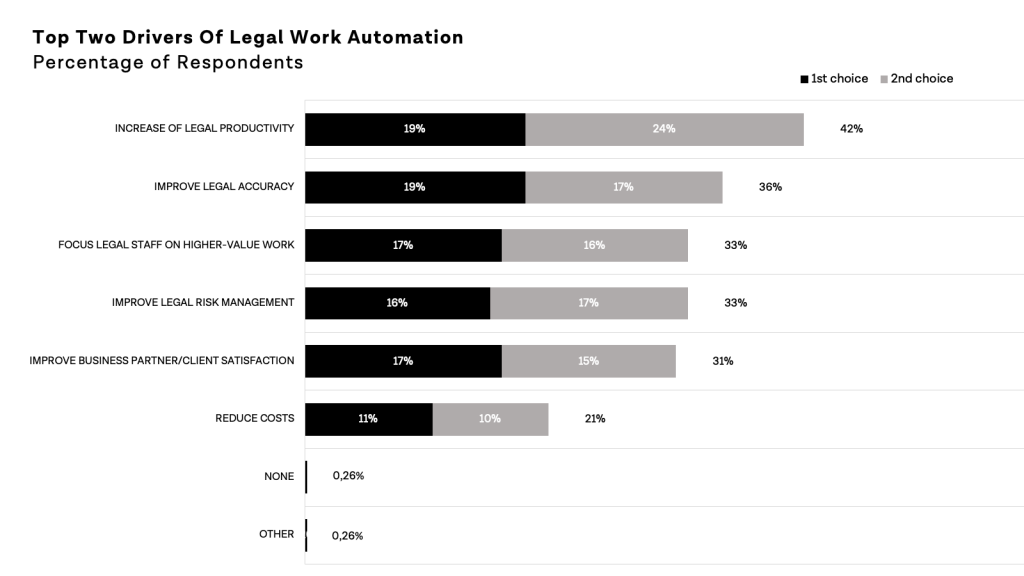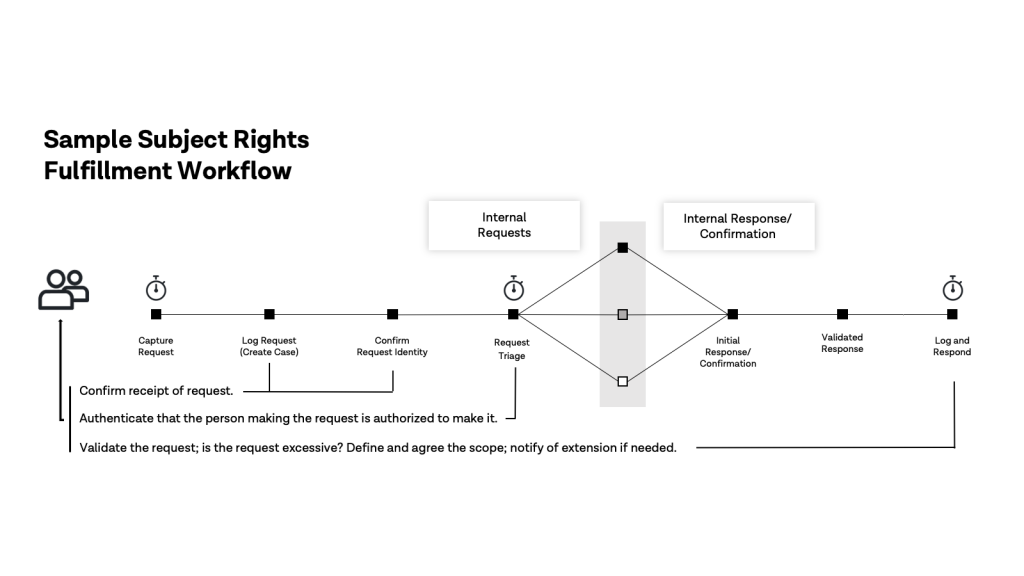As pressure grows in corporate legal departments to reduce response times and increase efficiency, Gartner predicts that law-bots will handle a quarter of internal legal requests by 2023. Standardization and repeatability are the main characteristics of potential workflows ripe for legal automation.
The main characteristics of workflows ripe for legal automation are those with some degree of standardization and repeatability. For example, it is becoming increasingly difficult for organizations to use manual workflows to comply with the ever more onerous obligations on data controllers and processors, such as Subject Rights Requests (SRRs).
Automation is closing the gap between law and tech
Gartner, a leading IT research and consultancy company, has now published a report on the results of a study conducted to exploring the gap between the potential for automation and the current level of automation in legal activities. The study also looked into the processes and skills necessary for automation and whether the potential returns from automation justify the investment.
According to the report, increasing productivity in a legal department is the main driver for automating legal work. As a result, legal departments are becoming more and more interested in technology that can help them accelerate internal workflows. As Gartner reports:
42% of corporate legal departments will increase investment in dedicated solutions for automated processing of legal inquiries and cases by at least 10% percent over the next three years.
Investing in legal workflow automation ensures the efficiency of key legal and compliance functions, mitigates risks arising from an inconsistent approach to legal issues and reduces the complexity of compliance in an enterprise.

The more internal legal inquiries a legal team receives, the greater the pressure on that team to improve operational capacity. Innovative technologies in the form of Virtual Legal Assistants (VLAs), legal chatbots and law-bots enable these teams to respond effectively to the increase in demand for their services. Moreover, the use of these advanced technologies ensures consistency across corporate digital strategies, allowing legal departments to keep pace with digital developments across the wider organization.
In addition, the use of such advanced technologies ensures homogeneity
in corporate digital strategies, as legal departments can keep pace with digital developments of other departments avoiding technology breaks and duplication within the company.
By 2023, virtual legal assistants will field 25% of internal requests to legal departments at large enterprises, increasing operational capacity for in-house legal teams.
Virtual legal Assistant
According to Gartner’s glossary, virtual assistants (VAs) help enterprises with a set of tasks previously only made possible by humans. Virtual legal assistants use semantic and deep learning to assist people or automate legal tasks. Virtual legal assistants listen to and observe behaviors, build and maintain data models, and predict and recommend actions. They can be deployed in several use cases: personal assistants, virtual customer assistants, and virtual employee assistants.
A call to automation: stronger and more efficient legal departments
Standardization and repeatability are the main characteristics of the kind of workflows ripe for automation. Routine legal activities – such as commercial contract management – are among the core operations that internal legal teams are often entrusted with. Virtual legal assistants, law-bots or AI-based chatbots for business that provide internal legal services automatically are compelling examples of the impact that new technologies can make on the productivity of legal teams.
Self-servicing tool
Gartner’s glossary defines customer self-service and support as a blend of customer-initiated interaction technologies that are designed to enable customers to serve themselves. It includes electronic records management systems, chat and knowledge bases, and virtual employee assistants.
Law bot
Following Gartner’s glossary, a bot is a productivity tool that allows a user to configure one or more scripts to activate specific keystrokes in an automated fashion. With regard to the legal sector, bots can be used to mimic or emulate selected legal tasks within an overall legal operational process.
Gartner uses the California Consumer Privacy Act (CCPA) as an example to illustrate the potential of legal automation, considering the volume of requests arising from rights granted under this new regulatory framework is expected to be high. This is the first time such rights (including the right of access to any of your data held by a third party and the right to have that data deleted) have been granted to U.S. citizens. The image below shows the structured workflow for addressing subject rights requests (SRRs).

Virtual legal assistants enable legal departments to streamline the process of receiving and reviewing legal inquiries and determining the need for legal review of an issue, such as addressing SRRs under the CCPA. VLAs can also prove to be particularly useful when employees contact the legal department with highly confidential issues, for example, reporting whistleblowers and workplace harassment. VLAs can provide the anonymity that many employees desire in these cases.
The legal arm of PwC, one of the big four consultancy firms, is currently using BRYTER no-code platform to build its own legal technology applications. These include self-service tools to drive optimization of processes and improve client experience. Tools, such as KYC software, NDA generators and compliance checkers as it can be a Strategic Trade Compliance Checker or a Securitization Regulation Checker, allow lawyers to reduce bottlenecks in workflows and spend more time on the core legal issues. This leads to more effective use of human input along with more efficient client service.
In general, the resources of legal departments have not kept up with the growing demand for legal services within organizations. The use of legal technology addresses these resource constraints by providing businesses with a very practical and effective means of increasing their output capacity.
Artificial intelligence
Gartner’s glossary states that AI applies advanced analysis and logic-based techniques, including machine learning, to interpret events, support and automate decisions, and take actions.
AI-based technologies will enable corporate legal departments to speed up legal processes and get their work completed faster. Legal departments will not only benefit from increased efficiency, but also from higher employee satisfaction and the ability to re-deploy their legal experts to higher-value, more demanding tasks.
From traditional
professionals to dynamic legal technology experts
Even though standardized and repeatable legal processes have great potential for automation, most legal departments do not have the personnel with the technological know-how necessary to implement legal technology. As a result, Gartner predicts that:
By 2023, 33% of corporate legal departments will have a dedicated legal technology expert to support the increasing automation of core in-house workflows.
As more and more companies invest in legal technology systems to improve the efficiency of their legal work, the need for technological expertise will also rise. Legal departments will need specialists who can maintain these systems and correct errors. These legal technology experts must be able to coordinate with corporate IT and external parties – such as law firms, legal service providers and, in some cases, clients – to ensure proper management, security and integration between systems.
Nonetheless, the undeniable benefits of innovative legal technology have attracted providers, to deliver AI-based applications that allow anyone to develop, manage, maintain, and share automation solutions without the expertise or support of a legal technology expert. The so-called no-code solutions with a legal focus for the automation and acceleration of decision-making structures are already enabling non-technical legal experts to create and provide an even wider range of virtual, AI-based legal assistants.
BRYTER is all about enabling experts to scale their knowledge. Book a demo to see how BRYTER service automation can transform your business.











